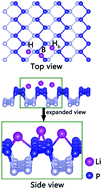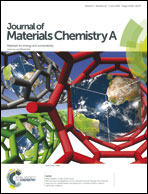Pristine and defect-containing phosphorene as promising anode materials for rechargeable Li batteries†
Abstract
The pristine and defect-containing phosphorene as promising anode materials for Li-ion batteries (LIBs) have been systematically investigated by first-principles calculations. The results suggest that the binding energies of Li adsorption on the different sites vary within a narrow range, and the binding between Li atom and pristine phosphorene is relatively weak. Interestingly, the defect can greatly improve the performance of the phosphorene in terms of both binding energy and diffusion of Li on phosphorene. The binding energy of Li around the vacancy created is increased by about 1 eV compared to that of the perfect phosphorene. More importantly, Li atoms could diffuse between two adjacent grooves with an energy barrier of 0.13 eV, which opens a novel channel for Li diffusion. This would dramatically improve the fast charge/discharge capability. These interesting properties indicate that the defect-containing PP has great potential to be a good electrode material in LIBs.


 Please wait while we load your content...
Please wait while we load your content...